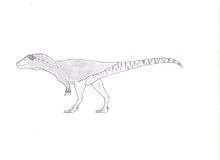Bahariasaurus
| Bahariasaurus Temporal range: Late Cretaceous, 95 Ma | |
|---|---|
 | |
| Bahariasaurus restoration, like megaraptoran | |
| Scientific classification | |
| Kingdom: | Animalia |
| Phylum: | Chordata |
| Class: | Reptilia |
| Clade: | Dinosauria |
| Order: | Saurischia |
| Suborder: | Theropoda |
| Family: | †Neovenatoridae |
| Clade: | †Megaraptora |
| Genus: | †Bahariasaurus Stromer, 1934 |
| Species | |
| |
| Synonyms | |
Bahariasaurus (meaning "Bahariya lizard") is a genus of large theropod dinosaur found in the Bahariya Formation in El-Waha el-Bahariya or Bahariya (Arabic: الواحة البحرية meaning the "northern oasis") oasis in Egypt and Kem Kem Beds of North Africa, which date to the late Cretaceous Period, (Cenomanian age), about 95 million years ago. It was a huge theropod, in the same size range as Tyrannosaurus and the contemporary genus Carcharodontosaurus.[1]
The type species, B. ingens, was described by Ernst Stromer in 1934,[2] though the type specimen was destroyed during World War II. The exact placement of Bahariasaurus is uncertain, although it has been variously assigned to several theropod groups, including Carcharodontosauridae (by Rauhut in 1995) and Tyrannosauroidea (by Chure in 2000). It is potentially synonymous with Deltadromeus, another theropod from the early Late Cretaceous of North Africa, this would possibly make it the largest ceratosaur.[3] More specimens would be needed to more accurately classify it, and to determine its relationship to Deltadromeus.[4][5]
In 2016 the description and analysis of Aoniraptor, Bahariasaurus was found along with Aoniraptor and Deltadromeus to probably form a still poorly known clade of megaraptoran tyrannosauroids different from the Megaraptoridae.[6]
References
- ↑ Smith, J.B.; Lamanna, M.C.; Lacovara, K.J.; Dodson, P.; Smith, J.R.; Poole, J.C.; Giegengack, R.; Attia, Y. (2001). "A Giant sauropod dinosaur from an Upper Cretaceous mangrove deposit in Egypt". Science. 292 (5522): 1704–1706. doi:10.1126/science.1060561. PMID 11387472.
- ↑ Stromer, E. (1934). "Ergebnisse der Forschungsreisen Prof. E. Stromers in den Wüsten Ägyptens. II. Wirbeltier-Reste der Baharije-Stufe (unterstes Cenoman)." 13. Dinosauria. Abhandlungen der Bayerischen Akademie der Wissenschaften, Mathematisch-naturwissenschaftliche Abteilung n.f., 22: 1–79.
- ↑ Holtz, Thomas R. Jr. (2008) Dinosaurs: The Most Complete, Up-to-Date Encyclopedia for Dinosaur Lovers of All Ages Supplementary Information
- ↑ Rauhut, (1995). "Zur systematischen Stellung der afrikanischen Theropoden Carcharodontosaurus Stromer 1931 und Bahariasaurus Stromer 1934." Berliner geowissenschaftliche Abhandlungen, E16 (Gundolf-Ernst-Festschrift): 357-375.
- ↑ Chure, (2000). "A new species of Allosaurus from the Morrison Formation of Dinosaur National Monument (Utah-Colorado) and a revision of the theropod family Allosauridae." Ph.D. dissertation, Columbia University, 1-964.
- ↑ Matías J. Motta; Alexis M. Aranciaga Rolando; Sebastián Rozadilla; Federico E. Agnolín; Nicolás R. Chimento; Federico Brissón Egli & Fernando E. Novas (2016). "New theropod fauna from the Upper Cretaceous (Huincul Formation) of northwestern Patagonia, Argentina". New Mexico Museum of Natural History and Science Bulletin. 71: 231–253.
